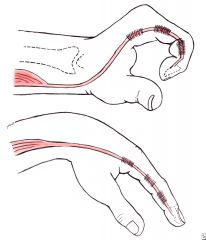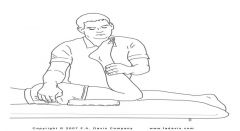![]()
![]()
![]()
Use LEFT and RIGHT arrow keys to navigate between flashcards;
Use UP and DOWN arrow keys to flip the card;
H to show hint;
A reads text to speech;
66 Cards in this Set
- Front
- Back
|
describe Functional ROM |
the ROM needed for functional activity
|
|
|
describe Functional Mobility
(what abilities needed (3x), for what purpose (2x)) |
the ability to |
|
|
how is Functional ROM compared to full or "normal" ROM?
|
Functional ROM =< full / normal ROM
|
|
|
Mobility is associated to Functional ROM through these:
(list) hint: all these need to perform properly to have good mobility |
joint integrity
flexibility of: -muscles -tendons, -fascia -joint capsules -ligaments -nerves -blood vessels -skin |
|
|
define Hypomobility
|
restricted motion caused by adaptive |
|
|
what is some general causes of Hypomobility?
(6 items) |
(1) prolonged immobilization
(2) sedentary lifestyle (3) postural malalignment, muscle imbalances (4) impaired muscle performance (weakness) (5) tissue trauma resulting in inflammation and pain (6) congenital or acquired deformities |
|
|
what is a general characteristic of Hypomobility?
(hint: characteristic associated with ROM) |
can't reach full ROM
|
|
|
what is "stretching for impaired mobility"
and it's purpose? |
any intervention designed to increase extensible of soft tissue
|
|
|
to maintain a gain in ROM, you should...
(perform these two activities) |
strength exercises
endurance exercises |
|
|
describe Flexibility
|
the ability to move a
-single joint or series of joints -smoothly and easily -through an unrestricted / pain-free ROM |
|
|
define Dynamic Flexibility
|
-active mobility or active ROM
-degree of active movement (your own muscle contractions) |
|
|
define Passive Flexibility
|
-passive mobility or passive ROM
-degree which a joint can be passively moved |
|
|
define Contracture
(2 characteristics, and 2 results) |
Adaptive shortening of: |
|
|
list 4 types of Contractures
|
Myostatic or Myogenic |
|
|
define Myostatic or Myogenic contractures
(3 characteristics) |
-muscle / tendon unit shortened |
|
|
define Pseudomyostatic contractures
|
-Apparent Contracture
-cause: hypertonicity (stoke, TBA, Neuro event) |
|
|
define Arthrogenic contractures
|
-Contracture due to reduced arthrokinematics
-Cause: intra-articular pathology ex: adhesions, synolvial proliferation, joint effusion, irregularities in articular cartilage, osteophyte formation |
|
|
define Fibrotic/Irreversible contractures
|
-Fibrotic Adhesions or Scar Tissue
-Irreversible; gains won't be as good as before -Cause: shortened immobilization of tissue + inflammatory response |
|
|
List reasons to Stretch
(5x) |
-limited ROM
-prevent deformities (from restricted motion) -muscle weakness/shortening of opposing tissue -prevent musculoskeletal injuries -minimize muscle soreness (after exercise) |
|
|
List contraindications of Stretching:
(7x) |
-bony block limits motion
-bone fracture not healed -soft tissue issue (inflammation/infection) -acute pain: joint/muscle -hematoma -hypermobility -Tenodesis |
|
|
What is Tenodesis?
|

Patients with paralysis/weakness:
Shortened tissue provides: -joint stability -functional skill |
|
|
Define Overstretching:
Overstretching can result in... |
stretch beyond normal muscle length
hypermobility detrimental whan cause joint instability |
|
|
how to treat Hypermobility:
(4x) |
-stabilization exercise
-mobility for stiff/hypomobile segments -strengthened in shortened range -postural training |
|
|
List 7 interventions to Increase Mobility:
|
-Manual, Mechanical / Passive, or Assisted Stretching |
|
|
Define Soft Tissue Properties: |
Ability of tissue to return to pre-stretch length after releasing
normal every day muscle length |
|
|
Define Soft Tissue Properties:
Viscoelasticity |
can stretch to a point, will initally resist but will give in after time (time-dependance)
most skeletal muscle ex: silly-puddy / pizza dough |
|
|
Define Soft Tissue Properties:
Plasticity |
Tendencacy of soft tissue to begin assuming new length of stretch (after removal of stretch)
|
|
|
list the muscle elements
(small -> large) |
actin/myosin proteins
myofilaments sarcomere (overlapping myofilaments) myofibril single fiber muscle |
|
|
What muscle related tissues HAVE BOTH
elastic/plastic properties? |
contractile
non-contractile (connective tissues) |
|
|
What muscle related elements DO NOT HAVE
visceolastic properties |
contractile elements
|
|
|
What muscle related elements HAVE
visceolastic properties |
non-contractile (connective tissues)
|
|
|
What type of muscle atrophies first
(with immobilization)? |
tonic, slow-twitch
ex: Postural muscles |
|
|
what are the two main muscle sensor organs?
|
muscle spindle
golgi tendon organ (GTO) |
|
|
Muscle Spindles mainly detect?
What nerves? |
changes in length/velocity of muscle
Type Ia afferent: quick/tonic stretch Type II afferent: tonic stretch |
|
|
What does the GTO detect?
(where and what nerves) |
muscle tension |
|
|
What does the GTO do during Isometric contractions?
|
Autogenic Inhibition
-sense tension -inhibits alpha motor neuron -allows muscle to elongate |
|
|
What is the main components of Connective Tissue?
|
Collage
Elastin / Reticulin Ground Substance |
|
|
What type of Collage Fibers are tendons/ligaments?
How many types are there? |
Type 1
(6 classes, 19 types) |
|
|
what is the main purpose of collagen fibers?
|
tensile strength
resist stretch |
|
|
what is the main purpose of elastin/reticulin fibers?
|
provide extensibility
reticulin = BULK |
|
|
what is the main purpose and composition of ground substance?
|
proteoglycans/glycoproteins
role: resists compression / stabilize transports nutrients hydrates prevent friction / cross linking ex: intervetebral discs |
|
|
What types of stress can be put on muscles?
|
tension
compression shear |
|
|
on a Stress-Strain Curve,
what are the 3 regions |
toe region
elastic range plastic range |
|
|
Describe the stress/strain curve:
Toe Region |
Lots of deformation w/o a lot of force
(like daily Functional ROM) |
|
|
Describe the stress/strain curve:
Elastic range |
strain is proportional to stress
ex: a gentle stretch, muscle returns to resting length upper limit: "Elastic Limit" |
|
|
Describe the stress/strain curve:
Plastic Range |
located from the "Elastic Limit" to "Failure"
permanent deformation of tissue (rupturing of fibers, little tears, then remodeled) |
|
|
On a Stress-Strain Curve,
where is the greatest load you can sustain? |
top of curve, in Plastic region
"Ultimate strength" |
|
|
On a Stress-Strain Curve,
What is necking? |
after the max sustainable stress,
tissue is failing (elongating quickly) |
|
|
Concerning stretching,
What is creep? |
-apply load
-extended time -tissue elongates |
|
|
Concerning stretching what is
"Stress-Relaxation", and when does it occur? |
decreased tissue tension, after creep occurs
(stretching for hours/days) |
|
|
What main categories will cause changes in collagen,
affecting the stress-strain curve? |
-Immobilization
(weakening/adhesions) -repetitive loading causing heat (stress fracture/overuse syndrom) -Inactivity (decrease of collagen) -aging -corticosteroids (decrease strength) -injury |
|
|
Explain stabilization
(as far as stretching) |

Fixation - site of muscle attachment
Stretch - other body attachment |
|
|
Recommended stretching guidelines:
(intensity / duration / frequency / speed) |
low load/low intensity
15-30 sec duration slow speed Unknown: reps/frequency |
|
|
List 5 Stretching categories?
|
static
ballistic dynamic cyclic PNF |
|
|
Explain Ballistic stretching
give example |
high speed and high intensity stretch
ex: sprinters |
|
|
Explain Dynamic stretching
give example |
sport-specific
utilize speed of movement ex: funny toy-soldier video |
|
|
Explain Cyclic stretching
|
short duration / repeated
5-10 sec |
|
|
List two PNF stretching techniques
|
Contract-Relax (CR)
autogenic inhibition -------------------------------------------- Hold-Relax (HR) reciprocal inhibition -------------------------------------------- Hold-Relax with agonist contraction (HR-AC) |
|
|
Explain Contract-Relax
(procedure/mechanism) |
Autogenic Inhibition
-Passive stretch tight muscle (10 sec) -contract agonist (the same tight muscle, 6 sec) -GTO inhibits alpha motor neuron -Relax -Passive stretch tight muscle (30 sec) |
|
|
Explain Hold-Relax
(procedure/mechanism) |
Reciprocal Inhibition
-passive stretch tight muscle -isometric contract opposite muscle -relax -passive stretch |
|
|
Explain Hold-Relax with Agonist Contraction
(procedure/mechanism) |
Reciprocal Inhibition
-like hold-relax -Use own muscle to stretch more |
|
|
Effects of Stretching?
(short/long term) |
short term: elongate elastic components
long term: add new sarcomeres |
|
|
Give an example of adjuctive agents to stretching?
|
tissue heating + ROM exercises
|
|
|
Benefits of heat on collagen?
temperature? |
-easier to deform (stretch)
-103 DegF |
|
|
Best way to increase tissue heat?
|
10-15 min submax exercise
|
|
|
Two types of heat modalities?
(named after depth) |
Superficial heat - hot pack, whirlpool
0.5cm - 3cm 15-30 min ------------------------------------- Deep heat - ultrasound <5cm 5-10 min 1.0 - 2.0 W/cm2 |

